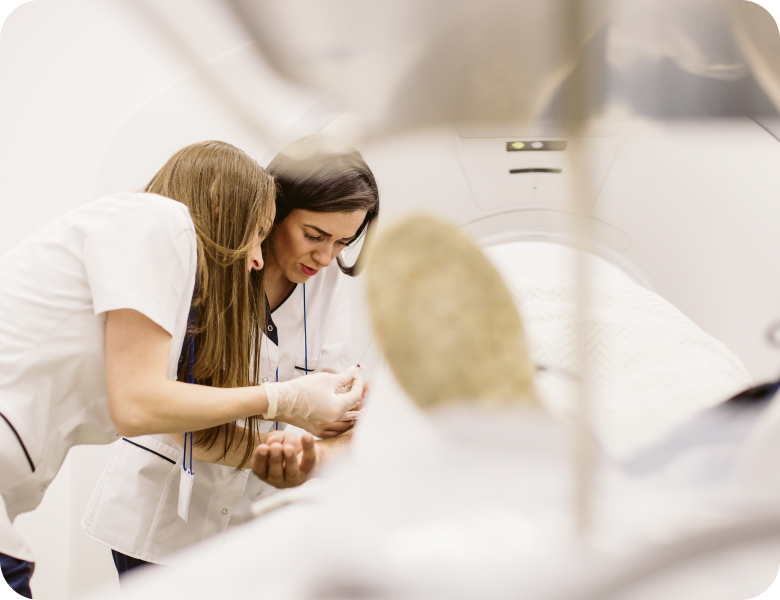The early detection of oncological pathology has become a priority for the Romanian state. Thus, in order to support patients and facilitate access to diagnosis, a new medical investigation dedicated to oncological suspicion has been introduced, with unlimited reimbursement.
Magnetic Resonance Imaging
What is Magnetic Resonance Imaging?
The first things to know about Magnetic Resonance Imaging (MRI) are that it does not expose us to radiation, is a painless technique, has no side effects, and can be repeated as often as needed without contraindications.
The Atlas Imagistica team relies on an MRI device, the RMN Signa Explorer 1.5 T, produced by General Electric. With the help of this and artificial intelligence software, our specialists interpret cardiac, oncological, and central nervous system examinations. Soon, we will extend artificial intelligence support to urological examinations.
One of our advantages is that Atlas Imagistica methods shorten post-investigation examinations, reducing the time allocated by a doctor for image interpretation from several hours to a few minutes.
Additionally, the software we use provides important information such as brain volume, cardiac volumes, and essential calculations. Access to a cloud-type database allows both us and the referring physician to track the evolution of a case permanently.

How do we prepare for MRI?
Our patients should know that Magnetic Resonance Imaging is very safe, and most people can undergo the procedure. On the day of an MRI, you should be able to eat, drink, and take any medication as usual, unless otherwise advised by the reception staff when scheduling the examination.
A blood test - serum creatinine - is necessary because contrast material (gadolinium) is sometimes administered for a better visualization of tissues.
Before entering the room with the device, you need to remove your jewelry, watch, glasses, hairpins, and any other objects that may contain metal (pen, keys, coins, hearing aids, piercings).
Of course, throughout the examination, you should follow the instructions of the specialized staff who assist and perform the investigation. At 'Atlas Imagistica,' you will have the chance to talk to the imaging specialist before the examination - we know how stressful the experience can be for a patient, so we are there to explain all the steps and make sure we address any concerns.
Contraindications
Implantable cardiac defibrillator
Cardiac pacemaker
Cochlear implants
Bullet, shrapnel, or any other type of metal fragment
Artificial heart valves
Medication delivery devices (insulin pump)
Tattoos - if they were done less than six weeks before the investigation
Pregnancy and Breastfeeding
If you are pregnant or think you might be pregnant, you should inform the radiologist about it. Although there is no study showing that MRI affects pregnancy in any way, as a precautionary measure, it is recommended to avoid this investigation in the first trimester of pregnancy.
Since MRI uses only magnetic fields and radio waves to obtain images, there are no concerns about performing this procedure during breastfeeding. Your child can resume breastfeeding immediately after the examination. Contrast material can also be used because a very small amount of gadolinium is excreted in breast milk.

How long does the investigation take?
An MRI examination can last from 15 minutes to over an hour, depending on the size of the scanned area and the number of images taken. You must remain still during the examination, as any movement during the investigation can artifact the resulting images.
During an MRI scan, the patient is inside the magnetic tube. Some patients may feel claustrophobic during the procedure. Therefore, patients with a history of claustrophobia should specify this. Relaxation is important during the procedure, and patients are asked to breathe normally. Our medical staff is always close to you during the maneuver.
In addition, there is a means of communication with the staff (such as a bell held by the patient), which can be used for contact in case the patient cannot tolerate the claustrophobic state.
At Atlas Imagistica, we understand and fully support patients, and when we feel that a person will feel more comfortable if accompanied during the examination, we allow it. We do this for children, leaving parents with them, and for other categories of patients in need.
What happens after the investigation is complete?
After the MRI scan is completed, the computer generates visual images from the scanned body area. All images taken will be written to a CD.
The result of the investigation is released by the radiologist in the form of a detailed medical report, after which the referring doctor will discuss the results with the patient and/or family.
At Atlas Imagistica, our imaging specialists have a discussion with the patient or family immediately after the examination to convey a preliminary conclusion - this may not always be requested, but we are there to give an initial opinion, to reassure, and explain.
The role of the referring doctor remains extremely important - they are the most capable of making the diagnosis, as they have all the medical data and know the entire clinical picture.


